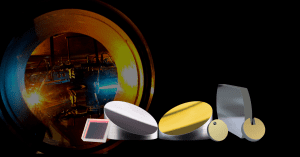Key Takeaways
- Ultra broadband metallic mirrors provide high reflectivity over a wide wavelength range (UV to NIR), outperforming standard metallic mirrors that only reflect well within narrower ranges.
- These mirrors are ideal for multi-purpose systems, offering flexibility, durability, and high damage thresholds.
- They perform consistently across various angles of incidence and are suited for applications like photon counting, hyperspectral imaging, and Raman spectroscopy.
Ultra Broadband Metallic Mirrors
Sometimes, standard metallic mirrors can’t reflect as much light as you need. That’s when you turn to an ultra broadband metallic mirror.
Broadband dielectric or metallic mirrors are excellent choices for many general-purpose applications, offering both performance and value. A good broadband mirror may suffice for applications requiring reflectivity from the UV to visible range or from visible to NIR. However, if you need high reflectivity from UV to NIR, an ultra broadband metallic mirror is what you want—a high-performance optic specifically designed to deliver superior results over a wide wavelength range. Thin metallic coatings—typically aluminum, gold, or silver—are enhanced with specialized dielectric coatings to boost reflectivity, ensure optimal surface quality, and provide critical protections.

Here we’ll look at some of the differences between ultra broadband metallic mirrors and other standard metallic mirrors. We’ll also have a brief look at some of the important applications of ultra broadband mirrors and why this specialized mirror is key to the high performance needed.
What Sets Ultra Broadband Metallic Mirrors Apart
The most obvious feature of ultra broadband metallic mirrors is their wide wavelength range. Standard metallic mirrors, in contrast, are optimized for a much narrower wavelength range. You might have a UV mirror or an IR mirror, depending on what you need it for. A third mirror might be designed for high reflectance in the visible. However, an ultra broadband mirror can reflect across all of those ranges.
High reflectivity or enhanced reflectance is another key feature of ultra broadband metallic mirrors. While other optical mirrors may have reflectivity as high as 99%, this is only true over a very narrow band. Outside this narrow wavelength, reflectivity drops drastically. An ultra broadband mirror, however, typically has average reflectivity of greater than 85 % up to 97.5 % for a broad spectral range. The exact reflectance depends on the design of the mirror.

Ultra broadband mirrors also offer more application flexibility compared to their non-ultra broadband counterparts. They may be an excellent choice for multi-purpose systems capable of working with different wavelengths of light. Applications like broadband lasers, spectroscopy, and imaging may all benefit from these versatile mirrors.
These mirrors are not just designed to reflect well over a wide range of wavelengths; they are also engineered to perform consistently at a wide range of angles of incidence. This is a contrast to standard metallic mirrors, where performance tends to degrade at angles other than normal incidence.
Another advantage is their durability. The careful engineering that goes into these specialized mirrors includes protective coatings against oxidation, heat, and moisture, often resulting in a high damage threshold.
Applications of Ultra Broadband Metallic Mirrors
High-performance ultra broadband mirrors are used in various applications, particularly when broadband reflectance is required or when an optical setup needs to accommodate different light frequencies.
Key applications include photon counting, hyperspectral imaging, and Raman spectroscopy.
In photon counting, light is relayed through a system, and individual photons are detected by a single-photon detector. Because these counters are highly sensitive, mirrors with very high reflectivity over all relevant bandwidths are essential. One notable use of photon-counting techniques is in medical scanning, where these systems enable ultra-high resolution CT imaging with minimal radiation exposure.

Ultra Broadband Metallic Mirrors at Avantier
At Avantier, we produce custom ultra broadband metallic mirrors as well as other custom optics upon request. Whether you need a specialized mirror for photon counting, Raman spectroscopy, or a Ti sapphire laser, we’ve got you covered. Contact us today for more information or to set up an initial consultation.
References
- Remy-Jardin, M., Hutt, A., Flohr, T., Faivre, J. B., Felloni, P., Khung, S., & Remy, J. (2023). Ultra-High-Resolution Photon-Counting CT Imaging of the Chest: A New Era for Morphology and Function. Investigative radiology, 58(7), 482–487.
- Sorokin, S. Naumov and I. T. Sorokina, “Ultrabroadband infrared solid-state lasers,” in IEEE Journal of Selected Topics in Quantum Electronics, vol. 11, no. 3, pp. 690-712, May-June 2005
GREAT ARTICLE!
Share this article to gain insights from your connections!







